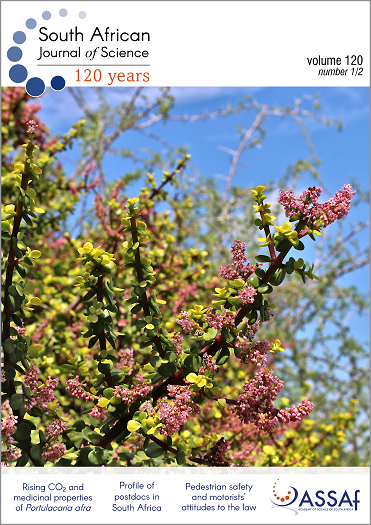The effect of elevated carbon dioxide on the medicinal properties of Portulacaria afra
DOI:
https://doi.org/10.17159/sajs.2024/15899Keywords:
antimicrobial, antioxidant, CO2, phytochemistry, African traditional medicineAbstract
There is a global concern that rising atmospheric CO2 concentrations may impact the medicinal or nutritional properties of medicinal plants. Portulacaria afra is a South African medicinal plant that is used by traditional healers to treat various skin conditions. The aim of this study was to determine whether elevated CO2 concentrations would affect the medicinal properties of the leaves of P. afra. This was achieved by comparing the phytochemical presence, antioxidant and antimicrobial activity of the leaves of P. afra which were exposed to ambient (420 ppm) and elevated (600 ppm) CO2 concentrations of plants grown in greenhouse conditions. The results revealed that leaf samples that were exposed to elevated CO2 concentrations exhibited a significant increase in flavonoid presence, compared to the control group. The antioxidant activity of the leaves of P. afra (DPPH activity) remained mostly unchanged in the samples that were exposed to elevated CO2 concentrations. The antimicrobial activity efficacy against Cutibacterium acnes increased with increasing global atmospheric CO2 concentration. These findings suggest that P. afra is a resilient medicinal plant and that its leaves may continue to provide relief against certain ailments, despite rising atmospheric CO2 concentrations.
Significance:
- Portulacaria afra is a South African medicinally important species that shows great resilience against elevated CO2 concentrations.
- It is important to anticipate how changing environmental factors, such as rising CO2 concentrations, may affect natural resources.
- The phytochemical profile and antioxidant and antimicrobial activities of the various plant parts either remained the same or increased after exposure to an elevated CO2 concentration of 600 ppm.
Published
Issue
Section
License

All articles are published under a Creative Commons Attribution 4.0 International Licence
Copyright is retained by the authors. Readers are welcome to reproduce, share and adapt the content without permission provided the source is attributed.
Disclaimer: The publisher and editors accept no responsibility for statements made by the authors
How to Cite
- Abstract 1095
- PDF 778
- EPUB 384
- XML 352
Funding data
-
National Research Foundation
Grant numbers TTK190401426371













.png)